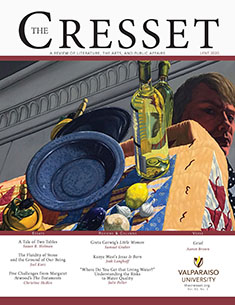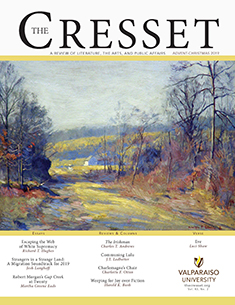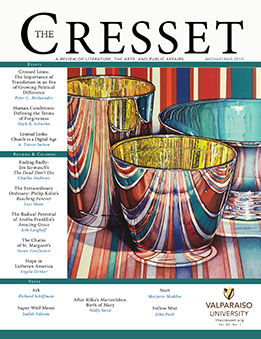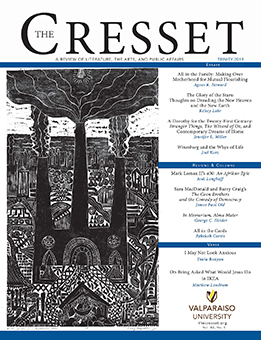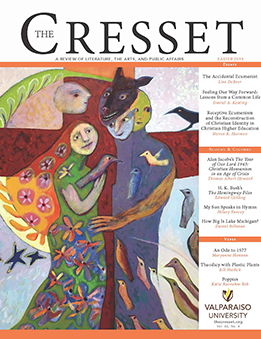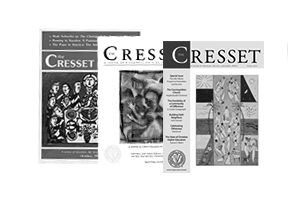Nonsmoking: On Principle and Compromise
People should not compromise their principles; they also should not believe that refusal to compromise is itself a principle. This was driven home for me when I served on a taskforce appointed by the Mayor of Valparaiso to consider whether or not to recommend to the City Council an ordinance prohibiting smoking in public places and, if the decision was in the affirmative, to draft a proposed ordinance to that effect. To give away the end of the “story,” after a year’s work, we recommended an ordinance which was passed by the Council in December 2006, took effect on 1 April 2007, and has been operating successfully (more or less) since then.
For me, however, the real “story” was not the result but the process, an odyssey in political philosophy, legal theories (from the sublime to the ridiculous), human psychology, science, education, and the power of dialogue. My most vivid memory from this odyssey is a moment at a taskforce meeting about ten months into our work immediately after each member, including I, had registered strong opposition to various aspects of the proposal then under consideration. Suddenly an epiphany hit me squarely between the eyes: “Everyone has found something to hate in this proposal. This baby is going to pass!” But let’s start at the beginning, first globally, then locally.
The Current Global Status of Smoking Regulation
The current international typhoon of smoking prohibitions is driven by greater scientific knowledge about the effects of “second-hand smoke.” Thus, unlike earlier anti-smoking crusades, these regulations are not aimed at paternistically protecting the smoker but protecting others who are impacted by its use.
The United States government has long been schizophrenic about the issue. The Surgeon General of the United States and the Centers for Disease Control and Prevention have issued major studies clearly demonstrating the negative effects of second-hand smoke. Federal law requires stern warnings on each pack of cigarettes and severely limits the advertisement of tobacco products. On the other hand, tobacco is a big part of our economy, tobacco makes an easy target for taxation, and tobacco growers actually receive government subsidies. The US relationship with tobacco bears an interesting (though not identical) resemblance to its relationship with gambling. As Yakov Smirnoff might say, “Government makes gambling illegal. Then the government runs or licenses huge gambling operations. What a country!”
Because of this, all of the regulation of second-hand smoke in our country has occurred at the state or local level. More than half of the US population lives in areas where tobacco is banned in all workplaces, bars, and restaurants. As of December 2005, however, Indiana had no such statute and no indication that one was imminent. Nor was there any indication that Porter County had an interest in addressing the question.
The City of Valparaiso Enters the Fray
At the urging of some City Council members, and because of his own interest in Valparaiso’s being a “Fit City,” Mayor Jon Costas decided to form a taskforce to study the problem at the local level. Afflicted with an unusual type of insanity, he asked me if I would chair it. I said “Yes... [there’s the Lutheran part of me] ... under certain conditions [there’s the lawyer].” The first condition was that two City Council members sit on the taskforce, one who was in favor of the regulation and one who was opposed. The two council members appointed (Jan Dick and Joey Larr) were not only devoted both to their starting positions and to the broad public interest but served as a continuous conduit to the other five council members, some of whom began to attend taskforce meetings (all open to the public under Indiana law). The second condition was that the Mayor, City Administrator, and I would work together to identify the other members. They included the Program Co-ordinator for the Tobacco Education and Prevention Coalition at Valparaiso University (Susan Gleason), a local restaurateur deeply respected by others in the restaurant and bar businesses (Russ Adams), and the recently retired HR Director for a major employer in Valparaiso (Chuck Parsons).
The Survey
The first decision the taskforce made was to commission a survey of local citizens on the question of regulating smoking in workplaces, restaurants, bars, and public places generally. Elected officials need to take the public’s pulse on controversial issues, and relying on only the small cadre of citizens who attend public meetings, a huge percentage of whom are NIMBYs, can be misleading. For the survey, we commissioned the Community Research and Service Center of the Department of Political Science at Valparaiso University. (The Director is Prof. Larry Baas, and the Associate Director is Prof. James Old, who is also editor of this publication.) We primarily wanted to measure the public’s opinion about city regulation of smoking in public places. Questions, of course, were also asked about opinions on health issues, whether people would stop (or start) going to restaurants or bars if smoking were prohibited, and all sorts of demographic questions for stratification purposes. But what we really wanted to know was what the populace thought about government regulation of smoking in the workplace, in restaurants, and in bars.
Of the twenty-five hundred questionnaires sent out, about 40 percent came back, a very high return rate indicative of passion on both sides. Here were the percentages in favor of regulation: in the workplace, 72.7%; in restaurants, 71.6%; in bars, 51.4%. I think almost every member of the taskforce and the council was astonished by these numbers. They do mimic national numbers, but one would expect them to be much lower in mid-western states where political scientists tell us people are more likely to (a) distrust government generally and (b) distrust professionals.
The Taskforce’s Self-Education
The taskforce educated itself in many other ways as well. We talked to many health-care professionals about the effects of second-hand smoke. Interestingly, not one person in this entire process, including those who absolutely hated the idea of any regulation, took issue with the fact that second-hand smoke creates serious health hazards, especially for children. Compare that with the endless quibbling over scientific questions in earlier anti-smoking campaigns or with today’s “climate change” (or “global warming”) issue.
We invited the owners and managers of bars and restaurants to several meetings, as they were clearly the persons who were most vulnerable to any such ordinance. Although the international and national experiences have shown that prohibiting smoking does not generally reduce business in bars and restaurants—though sometimes there is a short-lived downturn—the smaller the area being regulated, the greater the potential that the regulation could have negative competitive effects because people will just “shop” elsewhere. These were the most difficult, most vociferous meetings.
Law and Politics
Although the arguments opposing any regulation were often articulated in ersatz legalese, they were really statements of deeply held political philosophies, e.g., “How can you take away our customers’ right to smoke?”; “How can you take away my right to decide whether or not they smoke in my place?”; “This is just like Prohibition, and we know that was a failure.” At the center of much of this debate were strong feelings about the right of a premises owner to control his or her business and of individuals to choose to smoke. But these are not serious legal arguments. Government controls businesses in a myriad of ways from planning and zoning laws to a wide variety of health laws, and it controls all of us regardless of our particular location inside its borders (and sometimes outside of them too). If someone were charged with battering his or her spouse and argued, “What? Is the government now going to control what I do in my own house?” would we give that argument any consideration? What we were really hearing from these entrepreneurs was an understandable fear of the economic unknown coupled, in some cases, with a strong libertarian political philosophy. I would be remiss if I did not acknowledge that they conducted themselves at our meetings with great dignity despite their very deeply felt vulnerability.
The taskforce also interviewed (primarily by conference calls) key individuals from other cities in Indiana (Bloomington, Indianapolis, Lafayette) that had passed smoking regulation ordinances. The reports were consistent: (1) there was initial grousing and fear, but about four months after the ordinance took effect, everyone settled in and life went on as before except with less smoke; (2) enforcement will not be a large problem—most people want to comply with the law; and (3) almost everyone (including establishment owners) is happy with the overall effects of the ordinance. Now two years into the life of the Valparaiso ordinance, the same three statements could be made of our experience.
Compromise
The second breakthrough (the survey was the first) was the realization that a palatable compromise could be found. The anti-regulation people had taken note of the survey results and the testimony from other cities and were willing to consider some prohibitions. The pro-regulation people both respected the business owners’ fears and knew how to count to four (a majority of council members). They strongly suspected that the “whole enchilada” would not sell to four council members. The taskforce had received very little objection to workplace regulation. Thus, a workplace prohibition would clearly be included.
The thorny problem was going to be the “bar and restaurant” question. Our research had uncovered many attempts to work a compromise but one in particular emerged as the best for us in large part because of its elegant simplicity. The ordinance states to an owner who serves both food and alcohol: (1) if you run a “restaurant,” you may not allow smoking but may have people of any age (subject, of course, to other state regulations) as employees or customers; (2) if you run a “bar” and apply to the city for an exemption from the ordinance, which the city must grant, you may allow smoking but cannot have anyone under eighteen in your establishment either as employee or patron; and (3) you decide what your establishment is, but it must be one or the other, not both. This avoids the intrusiveness of regulators checking over books to see if alcohol or food predominates and thus actually contains a wisp of libertarianism. It also tracks the survey—remember that regulating “bars” had only a bare majority but that regulating “restaurants” had a large majority. I drafted a proposed ordinance which incorporated this exemption and added private clubs and retail tobacco stores as others who could apply for an exemption, and our taskforce, together with several other council members, met to consider it. Everybody ticked off precisely the aspects they hated about it, and I had my aforementioned epiphany. No one liked it 100 percent, but we could count five or six votes on the council (in part because the taskforce council members themselves were counting all the time too).
We also learned something surprising about a hidden benefit of regulation in general. Many restaurant owners told some of us (clandestinely), both before and after the ordinance passed, that they really did not want smoking going on in their places but were happy to “let the city pull the trigger.” That way they could remain the “good guys” to their patrons.
At taskforce public meetings and at the public hearing before the City Council all sorts of legal, political, economic, and social arguments were advanced. Many were fervent, some disingenuous, and some just zany. My favorite zany argument on this particular odyssey, which we heard on many occasions, goes like this: “How can you prohibit smoking when you’re doing nothing about industrial pollution?” or “...diesel fume emissions?” or “...the ozone layer?” What a lawyer would note is that the City of Valparaiso has no authority over issues which are pre-empted at either the federal or state level. What any rational person understands is that, assuming away this jurisdictional problem, a proposal to beef up pollution control could be met with the argument, “How can you do this and still let people smoke at the table next to me?” In short, the argument rests on the untenable tacit premise that we cannot fix anything until we fix everything.
The Denouement
At the public hearing before the Mayor and City Council, many members of the public spoke. The ratio of the comments were 6-1 in favor of the proposed ordinance. The council passed the ordinance 6-1. But what I was most thankful for was that the taskforce sent the proposal to council with unanimous 6-0 support.
Our letter of transmittal included this language: “The six of us came to this task with widely differing opinions. The current draft of an Ordinance is not what any single one of us would have wished at the beginning or perhaps even today. But we all view it as a fair solution, arrived at after giving careful respect to all opinions, fully consonant with the public’s wishes as manifest in the survey, and in the public interest.” This happened because people on the taskforce listened to each other. They talked, often forcefully, because they had strong opinions, but none of the opinions involved personal interest—all were centered on their own best understanding of the public interest. And each brought to the dialogue the one thing which makes dialogue possible—the concession, at least in theory, that he or she could be wrong.
Experience under the Ordinance
The council also passed a resolution asking the taskforce to report back eighteen months after the effective date and update the council as to its operation and any suggested changes. Our report (completed this past November) was predictable based on experience in other cities. There were only a few problems with cheating. There were no complaints that any workplace or restaurant was permitting smoking. A few of the “bars” who had obtained exemptions had to be reminded several times that they could not have patrons under eighteen present, and one had to be given a citation. No “restaurant” has changed to a “bar” (this is an annual choice), but we are beginning to see movement in the opposite direction. A few establishments initially reported some reduction in business but that has diminished and, besides, other factors these days can account for that reduction.
I was struck that as the taskforce met to prepare our eighteen-month report that not one of the six who had started in so many disparate positions wanted to recommend any major change. Part of that, of course, was the fear of re-opening Pandora’s Box and part was generated by the fact that there are now rumblings in Indianapolis about a statewide prohibition. But mostly I think it was because the ordinance has proven to be a non-perfect but workable solution which protects the huge majority from second-hand smoke yet keeps choice open for the most vulnerable establishment owners. The hard-core smokers still have their favorite haunts free of this particular form of governmental control, though many on the taskforce express sorrow for employees, entertainers, and those dragged along by friends to these places. There are only about seven such places left. Most restaurants have gone nonsmoking including, of course, all the national franchises and chains which are accustomed to this regulation at their other locations.
Conclusion
For me, this exercise was an enlightening affirmation of many truths: people agree far more than they disagree—they learn this through dialogue; most people who complain about the law abide by it; the City of Valparaiso has a Mayor and City Council who truly understand that public service is both critical and exasperating. And, finally, one other truth was reaffirmed—there are times when compromise itself actually is a principle.
Bruce Berner is the Louis & Anna Seegers Professor of Law at Valparaiso University School of Law.


